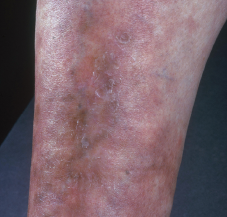“The intent is to identify similar groups of patients so that we can standardize recruitment into clinical trials and related studies. Often, the line is blurred between diagnostic and classification criteria,” said Dr. Grayson. “Unlike many classification criteria in the rheumatic diseases, we didn’t include mimics of vasculitis in our comparator groups. This is important. The intent of these criteria is to differentiate between different types of vasculitis, and the assumption of these criteria is that a diagnosis of vasculitis has already been made.”
These new, draft GPA classification criteria were developed with two methodology advancements, said Dr. Grayson. Instead of using a numerical scoring method in which each criterion carried the same weight, these criteria apply a different weight or score to each criterion and include a threshold score to achieve classification of the condition. In addition, the investigators created a gold standard that must be met in order to say a patient has the condition.

Vasculitis, the inflammatory destruction of blood vessels, is often an accompanying symptom of a rheumatic disease.
Biophoto Associates / Science Source
“Historically, submitted physician diagnosis or opinion was the gold standard, but the problem with that is that it can be biased,” said Dr. Grayson. “Previous classification criteria could influence opinions, so we utilized consensus expert panel reviews to validate the submitting physician diagnoses and establish the diagnostic gold standard.”
The study to develop the draft classification criteria included three phases, said Cristina Ponte, MD, a rheumatologist at the Hospital de Santa Maria in Lisbon, Portugal. The first phase was case selection, including a clinical expert panel review of case vignettes for quality control. Panelists reviewed each case to determine if the patient had vasculitis, and if so, what size vessels were affected, if it was ANCA-associated or not and its subtype. Detailed clinical, laboratory and radiological information on each patient case was included in the DCVAS online database. Consensus of at least two experts was needed to include the case.
In the second phase, the investigators selected 91 vasculitis-
related items from the previously agreed cases, on the basis of their prevalence or importance, for inclusion in a Lasso logistic regression model, said Dr. Ponte. The third phase was the creation of the final draft criteria, which used combined data-driven and clinical expert review, and then the models were tested for face validity and discrimination.
At the end of the process, nine items were included in the draft 2017 Provisional Classification Criteria for Granulomatosis with Polyangiitis (GPA) to use when a diagnosis of small- or medium-vessel vasculitis has been made and to classify the patient as having GPA, said Joanna Robson, BSc, PhD, MRCP, consultant senior lecturer in rheumatology at the University of West England in Bristol. Each item received either a positive or negative score, and when all items scores are added, the patient must reach a score of 5 or more to be classified as having GPA, she said.
Clinical Items & Their Scores
- Bloody nasal discharge, ulcers, crusting or sino-nasal congestion: 3
- Nasal polyps: –4
- Hearing loss or reduction: 1
- Cartilagenous involvement: 2
- Red or painful eyes: 1
Test Result Items & Their Scores
- c-ANCA- or PR3-antibody positive: 5
- Eosinophil count ≥1 (x109/L): –3
- Nodules, mass or cavitation on chest imaging: 2
- Granuloma on biopsy: 3
Renal impairment was highly prevalent in both cases and comparators, and did not emerge as discriminatory for GPA, said Dr. Robson. Kidney involvement will be a crucial item when diagnostic criteria are developed. DCVAS will seek endorsements from the ACR and EULAR for these classification criteria.



